Home / Birch Reduction
Reactions of Aromatic Molecules
Birch Reduction
Last updated: March 21st, 2025 |
Birch Reduction of Electron-Rich and Electron-Poor Aromatic Molecules – Examples and Mechanisms
The Birch Reduction is a process for converting benzene (and its aromatic relatives) to 1,4-cyclohexadiene using sodium (or lithium) as a reducing agent in liquid ammonia as solvent (boiling point: –33°C) in the presence of an alcohol such as ethanol, methanol or t-butanol.
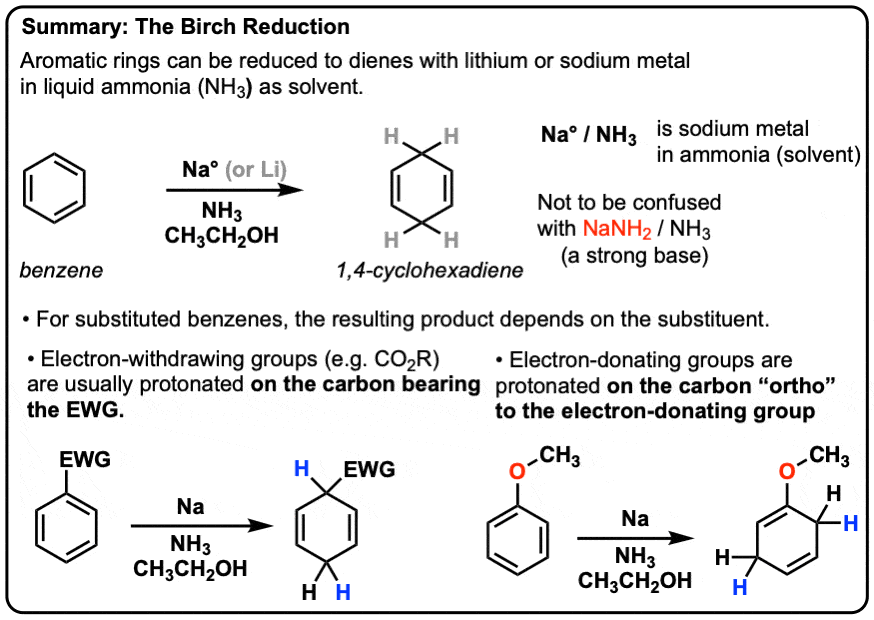
Table of Contents
- The Birch Reduction
- Mechanism Of The Birch Reduction
- Don’t Confuse Na/NH3 With NaNH2/NH3
- Substituent Effects In The Birch Reduction
- Aromatic Rings With Electron Withdrawing Groups (EWGs) Are Protonated Adjacent To The EWG
- Aromatic Rings With Electron Donating Groups (EDG’s) Are Protonated On The Carbon “Ortho” To The EDG
- Notes
- Quiz Yourself!
- (Advanced) References and Further Reading
1. The Birch Reduction
When benzene is treated with metallic sodium (or lithium) in liquid ammonia as a solvent, in the presence of a proton source (e.g. ethanol, methanol, or t-butanol) the result is the net reduction of one of the double bonds of the benzene ring to give 1,4-cyclohexadiene. This reaction is known as the Birch reduction. [Note 1]
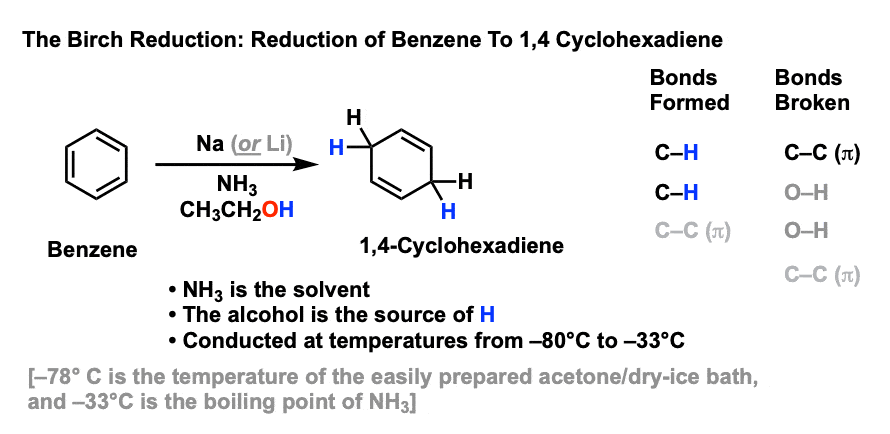
(I say “net” because two C-C pi bonds are broken and one C-C pi bond is formed)
Ordinary alkenes are unaffected by Birch reduction conditions. Conjugated alkenes can be reduced, however. Alkynes are partially reduced to give trans-alkenes under these conditions (see Na/NH3 reduction of alkynes)
2. Mechanism Of The Birch Reduction
Ammonia (NH3) is a gas at room temperature, boiling at a balmy –33 °C. Gaseous ammonia can be condensed to a liquid using a dry ice/acetone (–78°C) cold-finger, where it can serve as a solvent for alkali metals (e.g. Li, Na, and K). Although these metals are only sparingly soluble in liquid ammonia (about 1-5 g of Na per liter of NH3) the result is a spectacular blue color: once made, never forgotten.
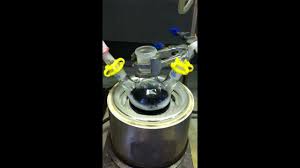
The intense blue color is due to the presence of solvated electrons (e –) , swimming in the ammonia solution. [Note 2]
Upon meeting benzene, an electron adds to the aromatic pi system, resulting in a radical anion with seven pi electrons. [Note 3]

[Note that in the arrow-pushing mechanism, two C-C pi bonds are broken and one C-C pi bond is formed, which is why we said that the reaction results in the net breakage of a C-C pi bond].
Being strongly basic, the radical anion is immediately protonated at carbon by the alcohol. [Note 4]
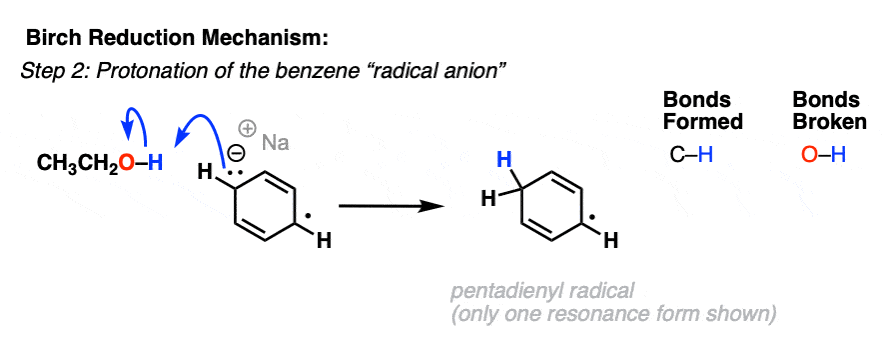
The resulting pentadienyl radical can then accept a second electron from the “electron soup”, resulting in a new anion (a “pentadienyl anion”). (why pentadienyl and not hexadienyl? see Note 5)
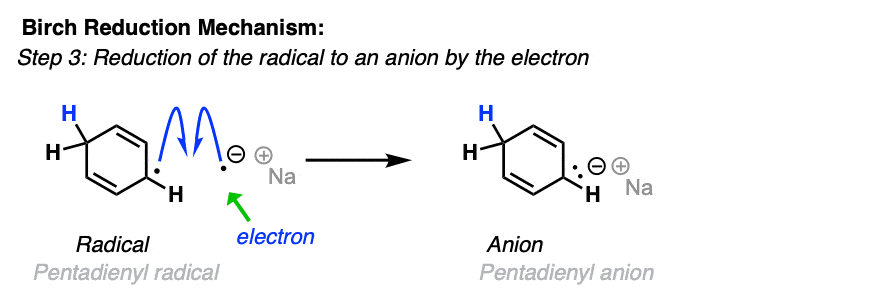
It is at this stage where the presence of an alcohol (e.g. ethanol or t-butanol) becomes necessary, since NH3 is not a strong enough acid to protonate this anion.
Protonation of this species, at the central carbon results in the 1,4-cyclohexadiene. Studies by 13-C NMR indicate that the central carbon has the highest electron density.
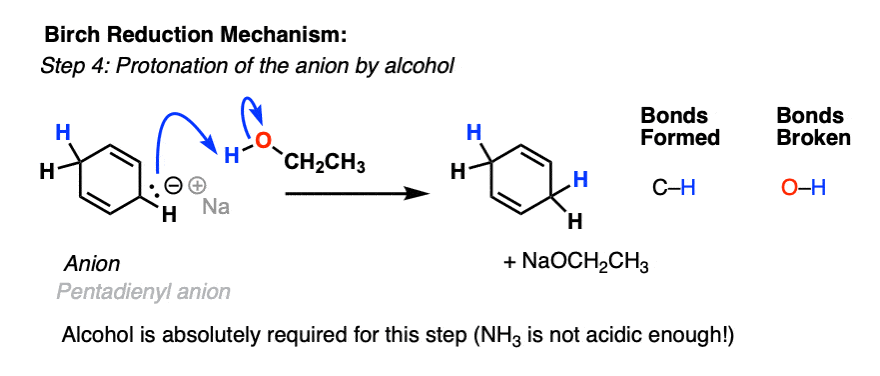
So although we said that the reaction involves the net breakage of a single pi bond, actually we break two pi bonds and form one.
3. Don’t Confuse Na/NH3 With NaNH2/NH3
Birch reduction conditions can easily be confused for conditions that form sodium amide (NaNH2).
The key is to know the difference between sodium metal (neutral, easily gives up its single electron) in NH3 (solvent) and NaNH2 (sodium amide, strong base) in NH3 (solvent, also conjugate base)
For example this is not a Birch reduction – this is elimination of a chloride to form benzyne followed by attack!
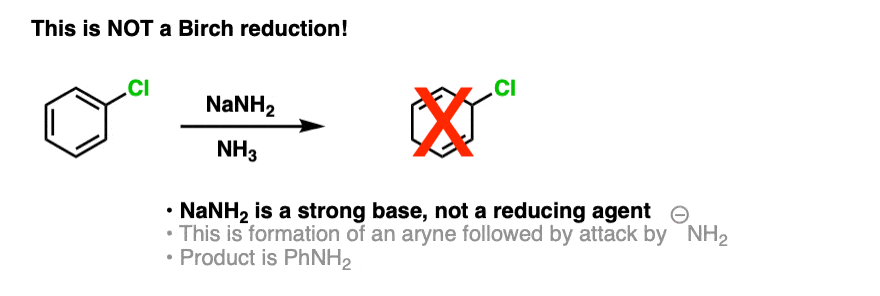
Another common mistake is to imagine that the role of Na / NH3 is to put an NH2 on the ring. This is also incorrect.

4. Substituent Effects In The Birch Reduction
The next question to ask is, what happens when substituents are present on the ring? What kinds of products are obtained?
Since the “nucleophile” here is essentially free electrons (e – ) , the reaction is faster on aromatic rings with electron-withdrawing substituents (e.g. CO2H) and slower on aromatic rings with electron-donating substituents (OCH3).
Electron-withdrawing substituents and electron-donating substituents also give different products.
With electron withdrawing groups you get protonation adjacent to the electron-withdrawing group.
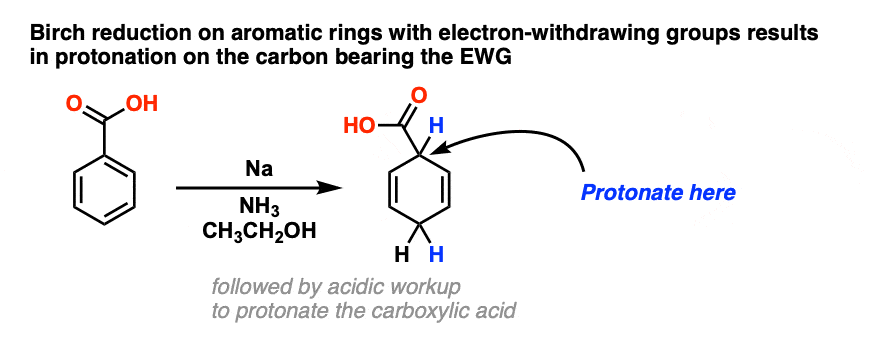
With electron donating groups like OCH3 you get protonation on the carbon adjacent to the carbon bearing the OCH3 (“ortho” to the -OCH3). Like this:
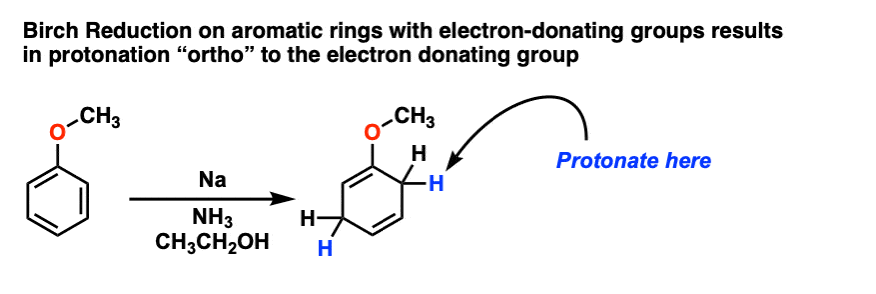
Why the difference?
When a substituent is present, the formation of the first C–H bond determines which product will form. This, in turn, depends on the site where the most stable anion will form.
5. Aromatic Rings With Electron Withdrawing Groups (EWGs) Are Protonated Adjacent To The EWG
When an electron-withdrawing group like CO2CH3 is present, the anion can be delocalized through resonance from carbon to oxygen (which being more electronegative, is much better at stabilizing negative charge). Recall that this is an example of the CO2CH3 being a pi acceptor.
The protonation thus occurs on the carbon bearing the electron-withdrawing (i.e. pi-accepting) substituent. [Note 6]
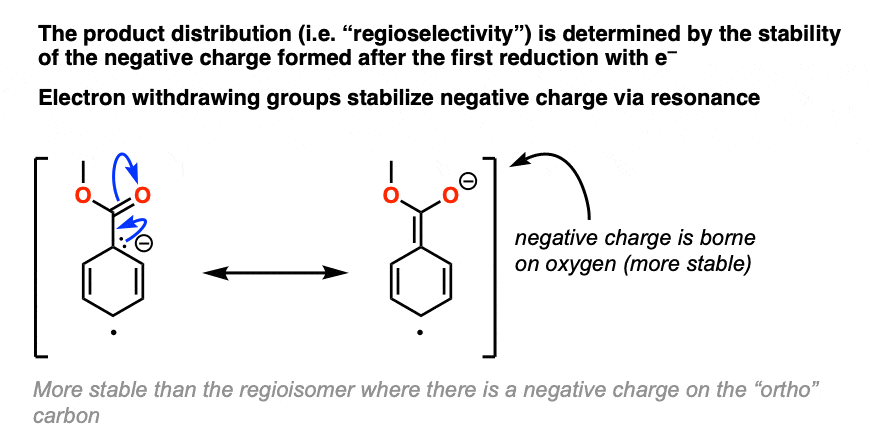
6. Aromatic Rings With Electron Donating Groups (EDG’s) Are Protonated On The Carbon “Ortho” To The EDG
When there’s a group that’s a strong pi donor (OCH3) then formation of an anion adjacent to that group is actually disfavored. Electrons repel, after all!
In this case the product is determined by placing the negative charge as far away from the pi-donating group as possible.
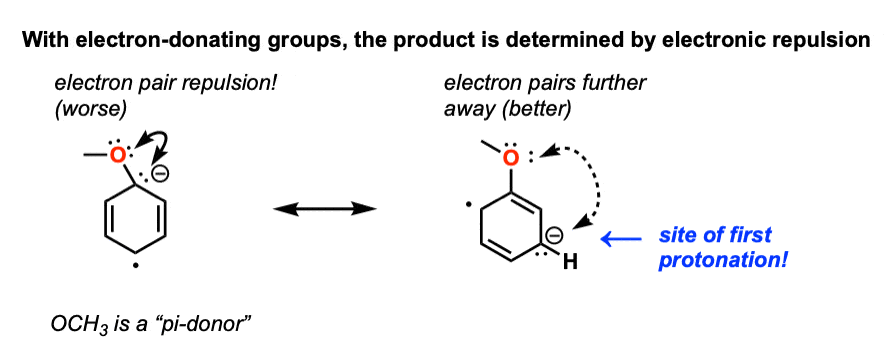
The resulting vinyl ethers can be hydrolyzed to ketones with aqueous acid. This process became particularly important in the development of steroid hormones, which led to the development of the birth control pill. For instance the synthesis of norethisterone from estradiol relied on a Birch reduction, which we explored a little bit in this post.
As Carl Djerassi once said, “Que viva Don Arturo Birch! ”
7. Birch Reduction of Anthracene
Another interesting dissolving metal reduction is that of the polyaromatic hydrocarbon anthracene.
Anthracene contains three aromatic rings and has a total resonance energy (i.e. the stabilization due to aromaticity) of 83 kcal/mol, or about 27.7 kcal/mol per ring (compare to 36 kcal/mol for benzene). [Ref]
Anthracene undergoes Birch reduction such that the central aromatic ring is reduced and a total of two hydrogens are added to the molecule. [Note 8]. The resulting hydrocarbon has two aromatic rings for a total resonance energy of about 72 kcal/mol. [Procedure here]
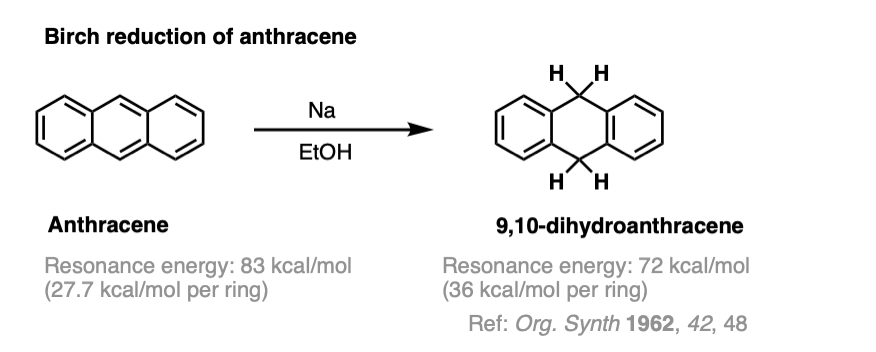
(Yes, the numbering system on anthracene is weird)
This is considerably more stable than, for example, reduction of the far aromatic ring to give a substituted naphthalene; naphthalene has a resonance stabilization energy of only 61 kcal/mol (approx 30.5 kcal/mol per ring).
Notes
Related Articles
- Synthesis (7): Reaction Map of Benzene and Related Aromatic Compounds
- Partial Reduction of Alkynes With Lindlar’s Catalyst or Na/NH3 To Obtain Cis or Trans Alkenes
- Aromatic Synthesis (1) – “Order Of Operations”
- Synthesis of Benzene Derivatives (2) – Polarity Reversal
- Nucleophilic Aromatic Substitution (2) – The Benzyne Mechanism
- Conjugation And Resonance In Organic Chemistry
- Exploring Resonance: Pi-Donation
- Exploring Resonance: Pi-acceptors
Note 1. Although the reduction of toluene and methoxybenzene was first reported by Wooster and Godfrey in 1937, the reaction came to be known as the Birch reduction after Prof. Arthur J. Birch, an Australian chemist working as a postdoc under Nobel Laureate Robert Robinson, nailed down the structure of the product in 1944 as a 1,4-cyclohexadiene derivative . As noted by John Cornforth in Birch’s biography, Robinson (who was largely away from the lab at this time, assisting with the war effort) disapproved of the time Birch spent developing this reaction.
Birch’s second key contribution in the reduction of methoxybenzene was demonstrating that the enol ether could be hydrolyzed to a ketone. This reaction eventually became very important in the synthesis of steroid derivatives. The first chemist to call this reaction the “Birch reduction” was Carl Djerassi, the “father of The Pill”. [See: The Organic Chemistry Behind, “The Pill”]
Note 2. The nucleophile here is therefore not sodium but “electron”. A reaction that occurs without two molecules having to collide into each other might seem weird – like procreation without sex. The analogy to artificial insemination is apt, as the reaction can be conducted using a battery as a source of electrons without the need for any sodium whatsoever.
Note 3. Drawing out the molecular orbitals of the benzene “radical anion” is a good exam question.
Note 4. The second protonation event is responsible for the formation of the 1,4 diene. Why does the (non-conjugated) 1,4-diene form and not the (conjugated, therefore more stable) 1,3- diene? According to 13C NMR studies, the central carbon is more electron-rich and the rationale is that the reaction happens fastest (and irreversibly) at this position. This is therefore an example of kinetic control.
In the absence of a proton source like CH3CH2OH the first protonation happens (via the solvent NH3), but NH3 is not acidic enough to do the second protonation. If the alcohol (like CH3CH2OH or t-BuOH) is absent, the result is C-C bond formation between the reduced benzene rings.
Note 5. Why pentadienyl and not hexadienyl? Because there are 5 p-orbitals in the conjugated system (since the other carbon in the ring is now a CH2 and can’t participate in resonance).
Note 6. Since the reaction medium is quite basic, if protonation happened on oxygen the resulting product would quickly be deprotonated again. Protonation on carbon, on the other hand, is irreversible.
Note 7. This application of the Birch reduction as a “masking group” for a beta-keto ester is pretty clever. (Reference 7).
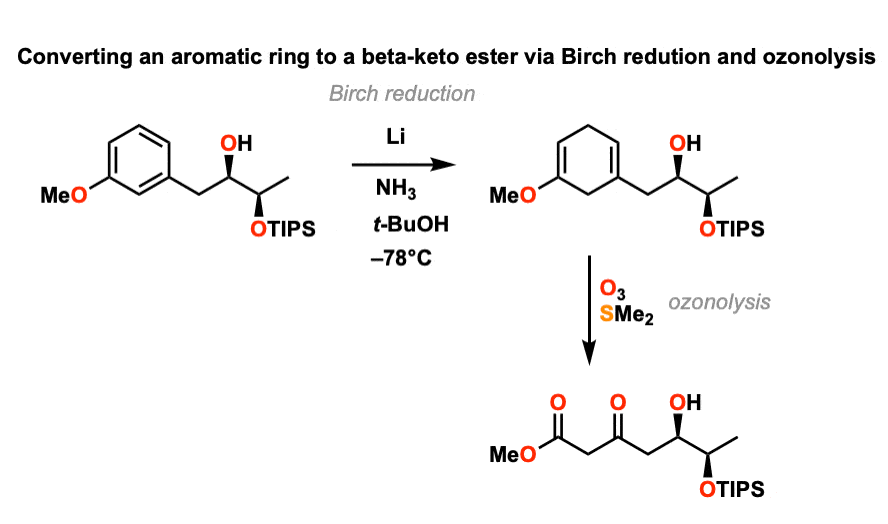
Note 8. Note that this is technically a “dissolving metal reduction”, not a “Birch reduction” since NH3 is not being used as the solvent.
Quiz Yourself!
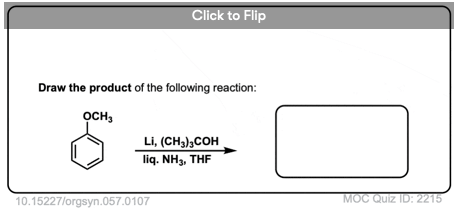
Become a MOC member to see the clickable quiz with answers on the back.
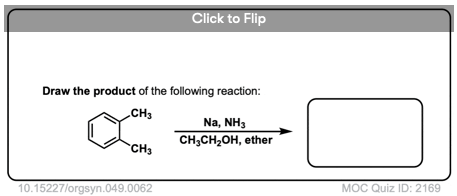
Become a MOC member to see the clickable quiz with answers on the back.
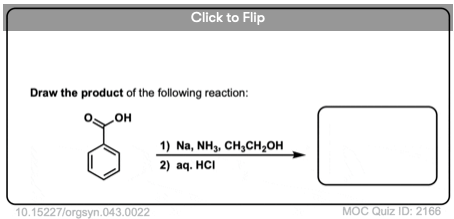
Become a MOC member to see the clickable quiz with answers on the back.
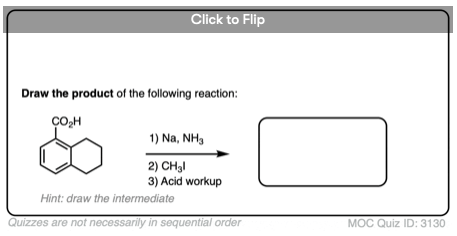
Become a MOC member to see the clickable quiz with answers on the back.
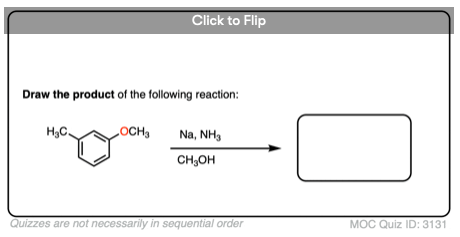
Become a MOC member to see the clickable quiz with answers on the back.
(Advanced) References and Further Reading
This article from the In The Pipeline blog by Derek Lowe provides an accessible (no formulae), colorful, and interesting background on the Birch reduction, along with a discussion of a recent (2019) advance in the electrochemical Birch reduction (see reference 8).
Running A Birch Reduction. From ChemTips
These handouts on the Birch Reduction from the groups of Prof. Andrew G. Myers (Harvard) and Prof. Phil S. Baran (Scripps) are particularly useful for advanced undergraduate / graduate-level students
Nobel Laureate Sir John Cornforth wrote a biographical sketch of Birch in Biographical Memoirs of Fellows of The Royal Society. This paper also notes the first chemist to use the term “Birch Reduction” was Carl Djerassi.
Primary Literature
- Umsetzungen von ungesättigten und mehrkernigen aromatischen Kohlenwasserstoffen mit Natrium und Calcium in flüssigem Ammoniak
Walter Hückel and Horst Bretschneider
Lieb. Ann. Chem. 1939, 540 (1), 157-189
DOI: 10.1002/jlac.19395400112 - Mechanism of the Reduction of Unsaturated Compounds with Alkali Metals and Water
Charles Bushnell Wooster and Kenneth L. Godfrey
Journal of the American Chemical Society 1937, 59 (3), 596-597
DOI: 10.1021/ja01282a504
These two papers were precursors for Arthur Birch’s work – these describe the reduction of aromatic compounds using Na/NH3. - Reduction by dissolving metals. Part I
Arthur J. Birch
J. Chem. Soc., 1944, 430-436
DOI: 10.1039/JR9440000430
Birch’s first paper (of many) on the reduction of aromatics by Na+NH3, which has since come to bear his name. - The Birch Reduction of Aromatic Compounds
Rabideau, Peter W.; Marcinow, Zbigniew
Org. React. 1992, 42, 1-334
DOI: 10.1002/0471264180.or042.01
The significance of the Birch reduction should be evident here – this is the subject of a 300+ page review in Organic Reactions! This has everything you need to know on the reaction – history, development, mechanisms, reaction scope, and experimental procedures. - A Mechanistic Analysis of the Birch Reduction
Howard E. Zimmerman
Accounts of Chemical Research 2012, 45 (2), 164-170
DOI: 10.1021/ar2000698
This account by Prof. Zimmerman (a very influential figure in modern physical organic chemistry) summarizes work that has been carried out to establish the mechanism of the Birch reduction. - Reduction of Organic Compounds by Lithium in Low Molecular Weight Amines. I. Selective Reduction of Aromatic Hydrocarbons to Monoölefins
Robert A. Benkeser, Robert E. Robinson, Dale M. Sauve, and Owen H. Thomas
Journal of the American Chemical Society 1955, 77 (12), 3230-3233
DOI: 10.1021/ja01617a025
Similar to other dissolving metal reductions, the conditions of the traditional Birch reduction can be extended – Li can be used in the place of Na, and NH3 can be substituted with low-MW amines (e.g. methylamine). - Synthesis of 1,3-diol synthons from epoxy aromatic precursors: an approach to the construction of polyacetate-derived natural products
David A. Evans, Joelle A. Gauchet-Prunet, Erick M. Carreira, and Andre B. Charette
The Journal of Organic Chemistry 1991 56 (2), 741-750
DOI: 10.1021/jo00002a048
The source of the reaction scheme in the footnote. From the lab of Prof. David Evans (Harvard), a towering figure in modern natural product synthesis. - 1,4-DIHYDROBENZOIC ACID
M.E. Kuehne and B. F. Lambert
Org. Synth. 1963, 43, 22
DOI: 10.15227/orgsyn.043.0022
A reliable and reproducible Birch reduction procedure in Organic Syntheses, a source of independently tested synthetic organic laboratory procedures. This also shows the regioselectivity of reduction for arenes with EWG’s. - Scalable and safe synthetic organic electroreduction inspired by Li-ion battery chemistry
Peters, B. K. et. al.
Science, 22 Feb 2019: Vol. 363, Issue 6429, pp. 838-845
DOI: 10.1126/science.aav5606
A tour de force study on conducting electrochemical Birch reductions without sodium or ammonia on a wide range of substrates. - Resonance in Organic Chemistry
G. W. Wheland
Wiley, NY 1955.
Contains resonance energies for a large number of aromatic compounds based on thermodynamic data.
ISBN: QD471 .W57 1955
00 General Chemistry Review
01 Bonding, Structure, and Resonance
- How Do We Know Methane (CH4) Is Tetrahedral?
- Hybrid Orbitals and Hybridization
- How To Determine Hybridization: A Shortcut
- Orbital Hybridization And Bond Strengths
- Sigma bonds come in six varieties: Pi bonds come in one
- Dipole Moments and Dipoles
- A Key Skill: How to Calculate Formal Charge
- The Four Intermolecular Forces and How They Affect Boiling Points
- 3 Trends That Affect Boiling Points
- How To Use Electronegativity To Determine Electron Density (and why NOT to trust formal charge)
- Introduction to Resonance
- How To Use Curved Arrows To Interchange Resonance Forms
- Evaluating Resonance Forms (1) - The Rule of Least Charges
- How To Find The Best Resonance Structure By Applying Electronegativity
- Evaluating Resonance Structures With Negative Charges
- Evaluating Resonance Structures With Positive Charge
- Exploring Resonance: Pi-Donation
- Exploring Resonance: Pi-acceptors
- In Summary: Evaluating Resonance Structures
- Drawing Resonance Structures: 3 Common Mistakes To Avoid
- How to apply electronegativity and resonance to understand reactivity
- Bond Hybridization Practice
- Structure and Bonding Practice Quizzes
- Resonance Structures Practice
02 Acid Base Reactions
- Introduction to Acid-Base Reactions
- Acid Base Reactions In Organic Chemistry
- The Stronger The Acid, The Weaker The Conjugate Base
- Walkthrough of Acid-Base Reactions (3) - Acidity Trends
- Five Key Factors That Influence Acidity
- Acid-Base Reactions: Introducing Ka and pKa
- How to Use a pKa Table
- The pKa Table Is Your Friend
- A Handy Rule of Thumb for Acid-Base Reactions
- Acid Base Reactions Are Fast
- pKa Values Span 60 Orders Of Magnitude
- How Protonation and Deprotonation Affect Reactivity
- Acid Base Practice Problems
03 Alkanes and Nomenclature
- Meet the (Most Important) Functional Groups
- Condensed Formulas: Deciphering What the Brackets Mean
- Hidden Hydrogens, Hidden Lone Pairs, Hidden Counterions
- Don't Be Futyl, Learn The Butyls
- Primary, Secondary, Tertiary, Quaternary In Organic Chemistry
- Branching, and Its Affect On Melting and Boiling Points
- The Many, Many Ways of Drawing Butane
- Wedge And Dash Convention For Tetrahedral Carbon
- Common Mistakes in Organic Chemistry: Pentavalent Carbon
- Table of Functional Group Priorities for Nomenclature
- Summary Sheet - Alkane Nomenclature
- Organic Chemistry IUPAC Nomenclature Demystified With A Simple Puzzle Piece Approach
- Boiling Point Quizzes
- Organic Chemistry Nomenclature Quizzes
04 Conformations and Cycloalkanes
- Staggered vs Eclipsed Conformations of Ethane
- Conformational Isomers of Propane
- Newman Projection of Butane (and Gauche Conformation)
- Introduction to Cycloalkanes
- Geometric Isomers In Small Rings: Cis And Trans Cycloalkanes
- Calculation of Ring Strain In Cycloalkanes
- Cycloalkanes - Ring Strain In Cyclopropane And Cyclobutane
- Cyclohexane Conformations
- Cyclohexane Chair Conformation: An Aerial Tour
- How To Draw The Cyclohexane Chair Conformation
- The Cyclohexane Chair Flip
- The Cyclohexane Chair Flip - Energy Diagram
- Substituted Cyclohexanes - Axial vs Equatorial
- Ranking The Bulkiness Of Substituents On Cyclohexanes: "A-Values"
- Cyclohexane Chair Conformation Stability: Which One Is Lower Energy?
- Fused Rings - Cis-Decalin and Trans-Decalin
- Naming Bicyclic Compounds - Fused, Bridged, and Spiro
- Bredt's Rule (And Summary of Cycloalkanes)
- Newman Projection Practice
- Cycloalkanes Practice Problems
05 A Primer On Organic Reactions
- The Most Important Question To Ask When Learning a New Reaction
- Curved Arrows (for reactions)
- Nucleophiles and Electrophiles
- The Three Classes of Nucleophiles
- Nucleophilicity vs. Basicity
- What Makes A Good Nucleophile?
- What Makes A Good Leaving Group?
- 3 Factors That Stabilize Carbocations
- Equilibrium and Energy Relationships
- 7 Factors that stabilize negative charge in organic chemistry
- 7 Factors That Stabilize Positive Charge in Organic Chemistry
- What's a Transition State?
- Hammond's Postulate
- Learning Organic Chemistry Reactions: A Checklist (PDF)
06 Free Radical Reactions
- Free Radical Reactions
- 3 Factors That Stabilize Free Radicals
- Bond Strengths And Radical Stability
- Free Radical Initiation: Why Is "Light" Or "Heat" Required?
- Initiation, Propagation, Termination
- Monochlorination Products Of Propane, Pentane, And Other Alkanes
- Selectivity In Free Radical Reactions
- Selectivity in Free Radical Reactions: Bromination vs. Chlorination
- Halogenation At Tiffany's
- Allylic Bromination
- Bonus Topic: Allylic Rearrangements
- In Summary: Free Radicals
- Synthesis (2) - Reactions of Alkanes
- Free Radicals Practice Quizzes
07 Stereochemistry and Chirality
- Types of Isomers: Constitutional Isomers, Stereoisomers, Enantiomers, and Diastereomers
- How To Draw The Enantiomer Of A Chiral Molecule
- How To Draw A Bond Rotation
- Introduction to Assigning (R) and (S): The Cahn-Ingold-Prelog Rules
- Assigning Cahn-Ingold-Prelog (CIP) Priorities (2) - The Method of Dots
- Enantiomers vs Diastereomers vs The Same? Two Methods For Solving Problems
- Assigning R/S To Newman Projections (And Converting Newman To Line Diagrams)
- How To Determine R and S Configurations On A Fischer Projection
- The Meso Trap
- Optical Rotation, Optical Activity, and Specific Rotation
- Optical Purity and Enantiomeric Excess
- What's a Racemic Mixture?
- Chiral Allenes And Chiral Axes
- Stereochemistry Practice Problems and Quizzes
08 Substitution Reactions
- Nucleophilic Substitution Reactions - Introduction
- Two Types of Nucleophilic Substitution Reactions
- The SN2 Mechanism
- Why the SN2 Reaction Is Powerful
- The SN1 Mechanism
- The Conjugate Acid Is A Better Leaving Group
- Comparing the SN1 and SN2 Reactions
- Polar Protic? Polar Aprotic? Nonpolar? All About Solvents
- Steric Hindrance is Like a Fat Goalie
- Common Blind Spot: Intramolecular Reactions
- Substitution Practice - SN1
- Substitution Practice - SN2
09 Elimination Reactions
- Elimination Reactions (1): Introduction And The Key Pattern
- Elimination Reactions (2): The Zaitsev Rule
- Elimination Reactions Are Favored By Heat
- Two Elimination Reaction Patterns
- The E1 Reaction
- The E2 Mechanism
- E1 vs E2: Comparing the E1 and E2 Reactions
- Antiperiplanar Relationships: The E2 Reaction and Cyclohexane Rings
- Bulky Bases in Elimination Reactions
- Comparing the E1 vs SN1 Reactions
- Elimination (E1) Reactions With Rearrangements
- E1cB - Elimination (Unimolecular) Conjugate Base
- Elimination (E1) Practice Problems And Solutions
- Elimination (E2) Practice Problems and Solutions
10 Rearrangements
11 SN1/SN2/E1/E2 Decision
- Identifying Where Substitution and Elimination Reactions Happen
- Deciding SN1/SN2/E1/E2 (1) - The Substrate
- Deciding SN1/SN2/E1/E2 (2) - The Nucleophile/Base
- SN1 vs E1 and SN2 vs E2 : The Temperature
- Deciding SN1/SN2/E1/E2 - The Solvent
- Wrapup: The Key Factors For Determining SN1/SN2/E1/E2
- Alkyl Halide Reaction Map And Summary
- SN1 SN2 E1 E2 Practice Problems
12 Alkene Reactions
- E and Z Notation For Alkenes (+ Cis/Trans)
- Alkene Stability
- Alkene Addition Reactions: "Regioselectivity" and "Stereoselectivity" (Syn/Anti)
- Stereoselective and Stereospecific Reactions
- Hydrohalogenation of Alkenes and Markovnikov's Rule
- Hydration of Alkenes With Aqueous Acid
- Rearrangements in Alkene Addition Reactions
- Halogenation of Alkenes and Halohydrin Formation
- Oxymercuration Demercuration of Alkenes
- Hydroboration Oxidation of Alkenes
- m-CPBA (meta-chloroperoxybenzoic acid)
- OsO4 (Osmium Tetroxide) for Dihydroxylation of Alkenes
- Palladium on Carbon (Pd/C) for Catalytic Hydrogenation of Alkenes
- Cyclopropanation of Alkenes
- A Fourth Alkene Addition Pattern - Free Radical Addition
- Alkene Reactions: Ozonolysis
- Oxidative Cleavage of Vicinal Diols With NaIO4 and Pb(OAc)4
- Summary: Three Key Families Of Alkene Reaction Mechanisms
- Synthesis (4) - Alkene Reaction Map, Including Alkyl Halide Reactions
- Alkene Reactions Practice Problems
13 Alkyne Reactions
- Acetylides from Alkynes, And Substitution Reactions of Acetylides
- Partial Reduction of Alkynes With Lindlar's Catalyst
- Partial Reduction of Alkynes With Na/NH3 To Obtain Trans Alkenes
- Alkyne Hydroboration With "R2BH"
- Hydration and Oxymercuration of Alkynes
- Hydrohalogenation of Alkynes
- Alkyne Halogenation: Bromination and Chlorination of Alkynes
- Oxidation of Alkynes With O3 and KMnO4
- Alkenes To Alkynes Via Halogenation And Elimination Reactions
- Alkynes Are A Blank Canvas
- Synthesis (5) - Reactions of Alkynes
- Alkyne Reactions Practice Problems With Answers
14 Alcohols, Epoxides and Ethers
- Alcohols - Nomenclature and Properties
- Alcohols Can Act As Acids Or Bases (And Why It Matters)
- Alcohols - Acidity and Basicity
- The Williamson Ether Synthesis
- Ethers From Alkenes, Tertiary Alkyl Halides and Alkoxymercuration
- Alcohols To Ethers via Acid Catalysis
- Cleavage Of Ethers With Acid
- Epoxides - The Outlier Of The Ether Family
- Opening of Epoxides With Acid
- Epoxide Ring Opening With Base
- Making Alkyl Halides From Alcohols
- Tosylates And Mesylates
- PBr3 and SOCl2
- Elimination Reactions of Alcohols
- Elimination of Alcohols To Alkenes With POCl3
- Alcohol Oxidation: "Strong" and "Weak" Oxidants
- Demystifying The Mechanisms of Alcohol Oxidations
- Protecting Groups For Alcohols
- Thiols And Thioethers
- Calculating the oxidation state of a carbon
- Oxidation and Reduction in Organic Chemistry
- Oxidation Ladders
- SOCl2 Mechanism For Alcohols To Alkyl Halides: SN2 versus SNi
- Alcohol Reactions Roadmap (PDF)
- Alcohol Reaction Practice Problems
- Epoxide Reaction Quizzes
- Oxidation and Reduction Practice Quizzes
15 Organometallics
- What's An Organometallic?
- Formation of Grignard and Organolithium Reagents
- Organometallics Are Strong Bases
- Reactions of Grignard Reagents
- Protecting Groups In Grignard Reactions
- Synthesis Problems Involving Grignard Reagents
- Grignard Reactions And Synthesis (2)
- Organocuprates (Gilman Reagents): How They're Made
- Gilman Reagents (Organocuprates): What They're Used For
- The Heck, Suzuki, and Olefin Metathesis Reactions (And Why They Don't Belong In Most Introductory Organic Chemistry Courses)
- Reaction Map: Reactions of Organometallics
- Grignard Practice Problems
16 Spectroscopy
- Degrees of Unsaturation (or IHD, Index of Hydrogen Deficiency)
- Conjugation And Color (+ How Bleach Works)
- Introduction To UV-Vis Spectroscopy
- UV-Vis Spectroscopy: Absorbance of Carbonyls
- UV-Vis Spectroscopy: Practice Questions
- Bond Vibrations, Infrared Spectroscopy, and the "Ball and Spring" Model
- Infrared (IR) Spectroscopy: A Quick Primer On Interpreting Spectra
- IR Spectroscopy: 4 Practice Problems
- 1H NMR: How Many Signals?
- Homotopic, Enantiotopic, Diastereotopic
- Diastereotopic Protons in 1H NMR Spectroscopy: Examples
- 13-C NMR - How Many Signals
- Liquid Gold: Pheromones In Doe Urine
- Natural Product Isolation (1) - Extraction
- Natural Product Isolation (2) - Purification Techniques, An Overview
- Structure Determination Case Study: Deer Tarsal Gland Pheromone
17 Dienes and MO Theory
- What To Expect In Organic Chemistry 2
- Are these molecules conjugated?
- Conjugation And Resonance In Organic Chemistry
- Bonding And Antibonding Pi Orbitals
- Molecular Orbitals of The Allyl Cation, Allyl Radical, and Allyl Anion
- Pi Molecular Orbitals of Butadiene
- Reactions of Dienes: 1,2 and 1,4 Addition
- Thermodynamic and Kinetic Products
- More On 1,2 and 1,4 Additions To Dienes
- s-cis and s-trans
- The Diels-Alder Reaction
- Cyclic Dienes and Dienophiles in the Diels-Alder Reaction
- Stereochemistry of the Diels-Alder Reaction
- Exo vs Endo Products In The Diels Alder: How To Tell Them Apart
- HOMO and LUMO In the Diels Alder Reaction
- Why Are Endo vs Exo Products Favored in the Diels-Alder Reaction?
- Diels-Alder Reaction: Kinetic and Thermodynamic Control
- The Retro Diels-Alder Reaction
- The Intramolecular Diels Alder Reaction
- Regiochemistry In The Diels-Alder Reaction
- The Cope and Claisen Rearrangements
- Electrocyclic Reactions
- Electrocyclic Ring Opening And Closure (2) - Six (or Eight) Pi Electrons
- Diels Alder Practice Problems
- Molecular Orbital Theory Practice
18 Aromaticity
- Introduction To Aromaticity
- Rules For Aromaticity
- Huckel's Rule: What Does 4n+2 Mean?
- Aromatic, Non-Aromatic, or Antiaromatic? Some Practice Problems
- Antiaromatic Compounds and Antiaromaticity
- The Pi Molecular Orbitals of Benzene
- The Pi Molecular Orbitals of Cyclobutadiene
- Frost Circles
- Aromaticity Practice Quizzes
19 Reactions of Aromatic Molecules
- Electrophilic Aromatic Substitution: Introduction
- Activating and Deactivating Groups In Electrophilic Aromatic Substitution
- Electrophilic Aromatic Substitution - The Mechanism
- Ortho-, Para- and Meta- Directors in Electrophilic Aromatic Substitution
- Understanding Ortho, Para, and Meta Directors
- Why are halogens ortho- para- directors?
- Disubstituted Benzenes: The Strongest Electron-Donor "Wins"
- Electrophilic Aromatic Substitutions (1) - Halogenation of Benzene
- Electrophilic Aromatic Substitutions (2) - Nitration and Sulfonation
- EAS Reactions (3) - Friedel-Crafts Acylation and Friedel-Crafts Alkylation
- Intramolecular Friedel-Crafts Reactions
- Nucleophilic Aromatic Substitution (NAS)
- Nucleophilic Aromatic Substitution (2) - The Benzyne Mechanism
- Reactions on the "Benzylic" Carbon: Bromination And Oxidation
- The Wolff-Kishner, Clemmensen, And Other Carbonyl Reductions
- More Reactions on the Aromatic Sidechain: Reduction of Nitro Groups and the Baeyer Villiger
- Aromatic Synthesis (1) - "Order Of Operations"
- Synthesis of Benzene Derivatives (2) - Polarity Reversal
- Aromatic Synthesis (3) - Sulfonyl Blocking Groups
- Birch Reduction
- Synthesis (7): Reaction Map of Benzene and Related Aromatic Compounds
- Aromatic Reactions and Synthesis Practice
- Electrophilic Aromatic Substitution Practice Problems
20 Aldehydes and Ketones
- What's The Alpha Carbon In Carbonyl Compounds?
- Nucleophilic Addition To Carbonyls
- Aldehydes and Ketones: 14 Reactions With The Same Mechanism
- Sodium Borohydride (NaBH4) Reduction of Aldehydes and Ketones
- Grignard Reagents For Addition To Aldehydes and Ketones
- Wittig Reaction
- Hydrates, Hemiacetals, and Acetals
- Imines - Properties, Formation, Reactions, and Mechanisms
- All About Enamines
- Breaking Down Carbonyl Reaction Mechanisms: Reactions of Anionic Nucleophiles (Part 2)
- Aldehydes Ketones Reaction Practice
21 Carboxylic Acid Derivatives
- Nucleophilic Acyl Substitution (With Negatively Charged Nucleophiles)
- Addition-Elimination Mechanisms With Neutral Nucleophiles (Including Acid Catalysis)
- Basic Hydrolysis of Esters - Saponification
- Transesterification
- Proton Transfer
- Fischer Esterification - Carboxylic Acid to Ester Under Acidic Conditions
- Lithium Aluminum Hydride (LiAlH4) For Reduction of Carboxylic Acid Derivatives
- LiAlH[Ot-Bu]3 For The Reduction of Acid Halides To Aldehydes
- Di-isobutyl Aluminum Hydride (DIBAL) For The Partial Reduction of Esters and Nitriles
- Amide Hydrolysis
- Thionyl Chloride (SOCl2) And Conversion of Carboxylic Acids to Acid Halides
- Diazomethane (CH2N2)
- Carbonyl Chemistry: Learn Six Mechanisms For the Price Of One
- Making Music With Mechanisms (PADPED)
- Carboxylic Acid Derivatives Practice Questions
22 Enols and Enolates
- Keto-Enol Tautomerism
- Enolates - Formation, Stability, and Simple Reactions
- Kinetic Versus Thermodynamic Enolates
- Aldol Addition and Condensation Reactions
- Reactions of Enols - Acid-Catalyzed Aldol, Halogenation, and Mannich Reactions
- Claisen Condensation and Dieckmann Condensation
- Decarboxylation
- The Malonic Ester and Acetoacetic Ester Synthesis
- The Michael Addition Reaction and Conjugate Addition
- The Robinson Annulation
- Haloform Reaction
- The Hell–Volhard–Zelinsky Reaction
- Enols and Enolates Practice Quizzes
23 Amines
- The Amide Functional Group: Properties, Synthesis, and Nomenclature
- Basicity of Amines And pKaH
- 5 Key Basicity Trends of Amines
- The Mesomeric Effect And Aromatic Amines
- Nucleophilicity of Amines
- Alkylation of Amines (Sucks!)
- Reductive Amination
- The Gabriel Synthesis
- Some Reactions of Azides
- The Hofmann Elimination
- The Hofmann and Curtius Rearrangements
- The Cope Elimination
- Protecting Groups for Amines - Carbamates
- The Strecker Synthesis of Amino Acids
- Introduction to Peptide Synthesis
- Reactions of Diazonium Salts: Sandmeyer and Related Reactions
- Amine Practice Questions
24 Carbohydrates
- D and L Notation For Sugars
- Pyranoses and Furanoses: Ring-Chain Tautomerism In Sugars
- What is Mutarotation?
- Reducing Sugars
- The Big Damn Post Of Carbohydrate-Related Chemistry Definitions
- The Haworth Projection
- Converting a Fischer Projection To A Haworth (And Vice Versa)
- Reactions of Sugars: Glycosylation and Protection
- The Ruff Degradation and Kiliani-Fischer Synthesis
- Isoelectric Points of Amino Acids (and How To Calculate Them)
- Carbohydrates Practice
- Amino Acid Quizzes
25 Fun and Miscellaneous
- A Gallery of Some Interesting Molecules From Nature
- Screw Organic Chemistry, I'm Just Going To Write About Cats
- On Cats, Part 1: Conformations and Configurations
- On Cats, Part 2: Cat Line Diagrams
- On Cats, Part 4: Enantiocats
- On Cats, Part 6: Stereocenters
- Organic Chemistry Is Shit
- The Organic Chemistry Behind "The Pill"
- Maybe they should call them, "Formal Wins" ?
- Why Do Organic Chemists Use Kilocalories?
- The Principle of Least Effort
- Organic Chemistry GIFS - Resonance Forms
- Reproducibility In Organic Chemistry
- What Holds The Nucleus Together?
- How Reactions Are Like Music
- Organic Chemistry and the New MCAT
26 Organic Chemistry Tips and Tricks
- Common Mistakes: Formal Charges Can Mislead
- Partial Charges Give Clues About Electron Flow
- Draw The Ugly Version First
- Organic Chemistry Study Tips: Learn the Trends
- The 8 Types of Arrows In Organic Chemistry, Explained
- Top 10 Skills To Master Before An Organic Chemistry 2 Final
- Common Mistakes with Carbonyls: Carboxylic Acids... Are Acids!
- Planning Organic Synthesis With "Reaction Maps"
- Alkene Addition Pattern #1: The "Carbocation Pathway"
- Alkene Addition Pattern #2: The "Three-Membered Ring" Pathway
- Alkene Addition Pattern #3: The "Concerted" Pathway
- Number Your Carbons!
- The 4 Major Classes of Reactions in Org 1
- How (and why) electrons flow
- Grossman's Rule
- Three Exam Tips
- A 3-Step Method For Thinking Through Synthesis Problems
- Putting It Together
- Putting Diels-Alder Products in Perspective
- The Ups and Downs of Cyclohexanes
- The Most Annoying Exceptions in Org 1 (Part 1)
- The Most Annoying Exceptions in Org 1 (Part 2)
- The Marriage May Be Bad, But the Divorce Still Costs Money
- 9 Nomenclature Conventions To Know
- Nucleophile attacks Electrophile
27 Case Studies of Successful O-Chem Students
- Success Stories: How Corina Got The The "Hard" Professor - And Got An A+ Anyway
- How Helena Aced Organic Chemistry
- From a "Drop" To B+ in Org 2 – How A Hard Working Student Turned It Around
- How Serge Aced Organic Chemistry
- Success Stories: How Zach Aced Organic Chemistry 1
- Success Stories: How Kari Went From C– to B+
- How Esther Bounced Back From a "C" To Get A's In Organic Chemistry 1 And 2
- How Tyrell Got The Highest Grade In Her Organic Chemistry Course
- This Is Why Students Use Flashcards
- Success Stories: How Stu Aced Organic Chemistry
- How John Pulled Up His Organic Chemistry Exam Grades
- Success Stories: How Nathan Aced Organic Chemistry (Without It Taking Over His Life)
- How Chris Aced Org 1 and Org 2
- Interview: How Jay Got an A+ In Organic Chemistry
- How to Do Well in Organic Chemistry: One Student's Advice
- "America's Top TA" Shares His Secrets For Teaching O-Chem
- "Organic Chemistry Is Like..." - A Few Metaphors
- How To Do Well In Organic Chemistry: Advice From A Tutor
- Guest post: "I went from being afraid of tests to actually looking forward to them".
I’ll email him to see what he says!
He called all of them cyclohexadienyl!
Hmmm. Once the protonation happens and the pi-system only involves 5 p-orbitals, it’s now become pentadienyl.
My lecturer still called it a cyclohexadienyl radical/anion instead of pentadienyl. Is this something that varies depending on the person?
Depends on what stage of the reduction you’re talking about! The first addition of an electron products a cyclohexadienyl radical anion. After the first protonation happens, you get a pentadienyl radical, which is reduced to a pentadienyl anion by the second electron.
What is relative tendency of reduction of
1 tripple bond
2 conjugated double bond
3 Aromatic ring
Will the Birch reduction be added to the mechanism flashcards?
In the queue. Thanks for asking.
Why reduction stop at alkene in birch reduction?
1. You have claimed that olefins are are not reduced, but i think terminal olefins can be reduced. Correct me if I am wrong.
2. Could you please explain why it reduces selectively conjugative systems only?
3. Further reduction of 1,4-diene system happens if the reagent is added with alkyl amines, am i right? if yes, will it be stopped with olefin or produces cycloalkane?
Generally isolated alkenes are not affected by Birch conditions. In a Birch reduction the “nucleophile” is a solvated electron, and the electrophile is the lowest-unoccupied molecular orbital (LUMO) of the alkene. In a conjugated system the LUMO is considerably lower in energy than for an isolated alkene due to the larger pi-system.
It’s possible to increase the reducing power of the Birch by adding alkylamines (e.g. methylamine for the reduction of dienes like isoprene) but I have not seen examples for the reduction of isolated alkenes.
Thanks for solving the doubt.
“In the absence of a proton source like CH3CH2OH the first protonation happens, but not the second. The result is C-C bond formation between the reduced benzene rings.”
If no proton source is provided, how come will even the first protonation happen?
Good question. The first protonation is done by NH3 (solvent). I’ll update this paragraph. Thanks Spider